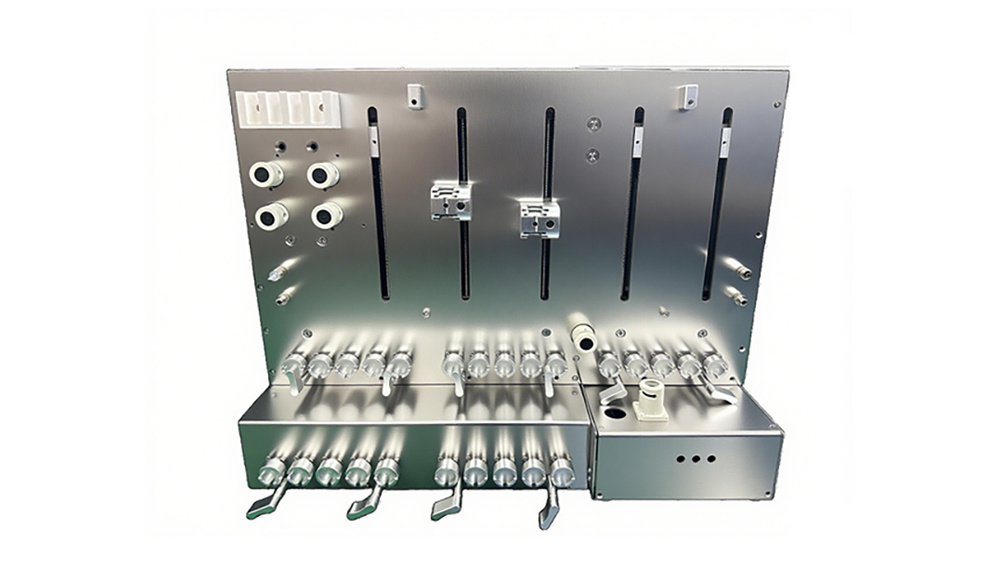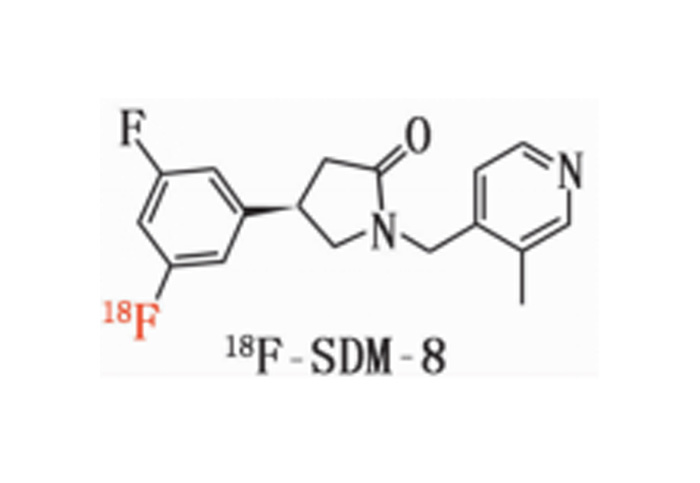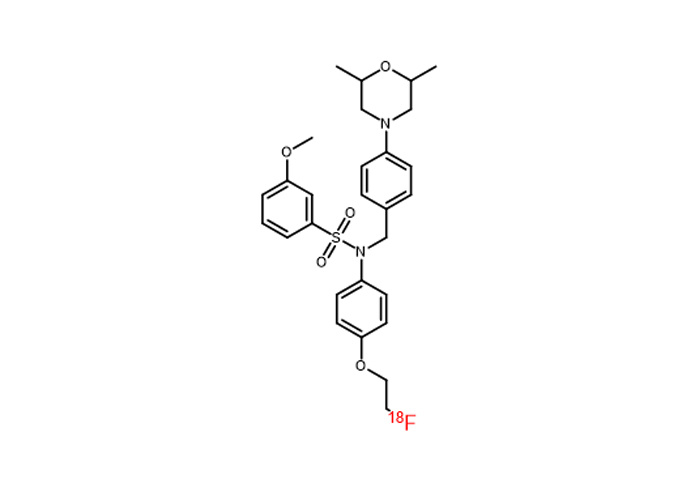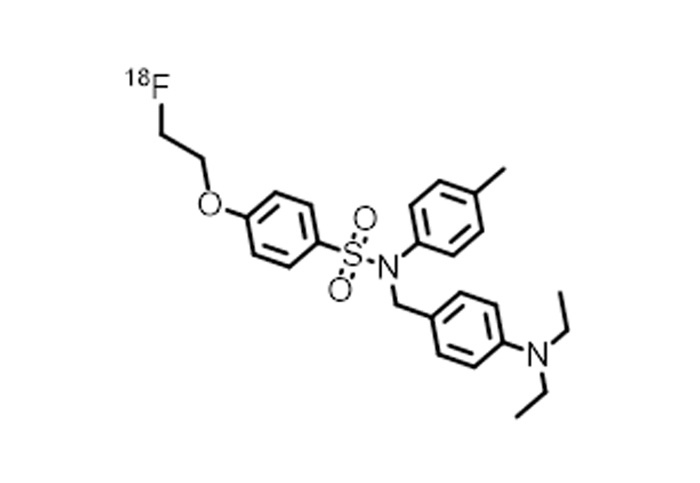
Products
Built multiple sets of modular, multi-functional intelligent drug automatic synthesis platform
18F-JR1003 material
Chinese invention patent application number: 2024112215845
Keywords: synthetic equipment disposable consumables
Classification:
Tracers

Hotline:
18F-JR1003 material
Graphic Details
1. Drug name (generic name, chemical name, English name, Pinyin, if there is a customized name, the basis of naming should be explained)
common name:
18F-JR1003
chemical name:
[[2-(2-chlorophenyl)-3-{4-[[(2-18fluoroethyl)oxy]phenyl]-5,6,7,8-tetrahydrooxazocycloheptamannadienyl [3,2-c]pyrazol-8-yl]amino)methylbenzyl ester] English name:
benzyl{[2-(2-chlorophenyl)-3-{4-[(2-18fluoroethyl)oxy]phenyl}-5,6,7,8-tetrahydrooxepino[3,2-c]pyrazol-8-yl]amino}methanoate
pin yin:
18F-JR1003
2. Chemical structure, molecular weight and molecular formula of the drug
chemical constitution:

18F-JR1003
3. Literature on the development and application of this product at home and abroad:
The endocannabinoid system (Endogenous Cannabinoid System, ECS) is a crucial signaling system in the central nervous system (Central Nervous System, CNS) of humans and animals. The ECS regulates important physiological processes such as pain, mood, stress, movement, and cognitive function. The ECS primarily consists of cannabinoid receptors, endogenous ligands, synthases, and degradases. Among these, cannabinoid receptors are divided into cannabinoid receptor type 1 (Cannabinoid Receptortype 1, CB1R) and cannabinoid receptor type 2 (Cannabinoid Receptortype 2, CB2R). Cannabinoid receptors are expressed throughout the nervous system, exhibiting unique pharmacological and physiological effects. They have long been considered an attractive target for disease treatment and drug development in the CNS by many researchers, including but not limited to chronic pain, epilepsy, anxiety, depression, Alzheimer's disease (Alzheimer's Disease, AD), Parkinson's disease (Parkinson's disease, PD), Huntington's disease (Huntington's disease, HD), amyotrophic lateral sclerosis (Amyotrophic Lateral Sclerosis, ALS), drug dependence, osteoporosis, and cerebrovascular diseases (Cerebrovascular Disease, CVD). Additionally, CB1R is abundantly expressed in peripheral nerves and tissues, such as in the gastrointestinal system: CB1R can regulate intestinal motility and the secretion of gastric acid and neurotransmitters, thereby affecting appetite and digestion; in the cardiovascular system, CB1R is significantly upregulated under pathological conditions; the expression of CB1R has also been detected in adipose tissue, bones, skin, and some cancer cells. Therefore, conducting research based on CB1R is crucial in both medical and pharmaceutical fields.
However, in general, the study of CB1R is based on a large number of in vitro or in vitro experiments, and there is a lack of in vivo visualization of cannabinoid 1 receptor.
Positron emission tomography (Positron Emission Tomography, PET) differs from structural imaging techniques such as magnetic resonance imaging (MRI) and computed tomography (CT). PET is a functional imaging technique that can display the metabolic activities of biomolecules, receptors, neurotransmitters, and other substances in living organisms. It is widely used in the diagnosis and differential diagnosis of various diseases, evaluation of therapeutic effects, research on organ functions, and the development of new drugs. PET imaging also boasts strong specificity, high sensitivity, and excellent penetration. Therefore, when diseases are in their early stages at the molecular level, and structural changes have not yet occurred in the affected areas, making it difficult for MRI or CT to provide a clear diagnosis, PET can sensitively detect the location of lesions and provide three-dimensional image information non-invasively, facilitating subsequent quantitative and qualitative studies and diagnoses by medical professionals. This is unparalleled by other imaging techniques. In PET, the core requirement is the use of PET imaging agents, also known as PET probes, PET contrast agents, or PET tracers. These are substances labeled with radioactive isotopes that specifically recognize and bind to specific target organs, tissues, enzymes, proteins, receptors, etc., upon entering the body. After entering the body, PET probes aggregate in specific regions and are then processed into three-dimensional images using signal acquisition equipment and computer imaging software. The most common PET probe is 18-fluorodeoxyglucose ([18F]FDG), which is a class of glucose metabolism probe that can be used to image the high sugar consumption parts of the body specifically, and has been widely used in tumor diagnosis and treatment.
Therefore, the development of specific PET probes for cannabinoid 1 receptor can solve the current dilemma of the lack of visualization research methods for cannabinoid 1 receptor. At present, no mature probes of this type have appeared on the market, and it is urgent to develop new CB1R-specific targeted probes.
4. Research methods, experimental conditions and other data of target organs and whole body imaging or simulated clinical function measurement tests of experimental animals, imaging or functional measurement results observed at various phases of the test
I. Whole body imaging and delayed imaging of experimental animals
1. Materials and methods
1.1 Experimental animals
The experimental animals were 2 mice, weighing about 25g, male, obtained from the laboratory of Zhejiang University. Images were collected at multiple time periods after drug injection to obtain the distribution map of the drug in vivo. After imaging, the experimental animals gradually woke up and returned to normal, with good diet, urine and feces, and mental state.
The figure below shows the 30min imaging image

2. Acute toxicity test
Take 10 healthy mice aged 6-8 weeks with a body weight of 20-25g, half male and half female, and inject 0.5mL of 18F-JR1003 with an activity of 1mCi via the tail vein. For the control group, take 10 healthy mice aged 6-8 weeks with a body weight of 20-25g, half male and half female, and inject 0.5mL of normal saline via the tail vein. Observe the survival status of both groups of mice; there was no statistically significant difference in the survival status within 7 days.
5. Instructions for drugs
Generic name: 18F-JR1003
Chemical name: {[2-(2-chlorophenyl)-3-{4-[(2-18fluoroethyl)oxy]phenyl}-5,6,7,8-tetrahydrooxazocycloheptamannadienyl [3,2-c]pyrazol-8-yl]amino)benzyl ester of methanolic acid
English name: Nbenzyl {[2-(2-chlorophenyl)-3-{4-[(2-18fluoroethyl)oxy]phenyl}-5,6,7,8-tetrahydrooxepino[3,2-c]pyrazol-8-yl]amino} methanoate
Pinyin: shiba F-JR yi ling ling san
[element]
The main component and its chemical name of this product are: G protein and its structural formula
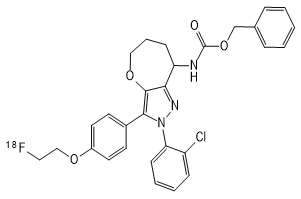
[shape and properties]
This product is a colorless clear or slightly yellow clear solution.
[indication]
18F-JR1003 is used for central nervous system diseases (depression, anxiety, etc.)
[18F-JR1003 PET/CT brain imaging process]
Preparation before inspection
Fasting requirements: The examinee should fast for 4-6 hours (water is allowed) to avoid blood glucose fluctuations that interfere with the distribution of the imaging agent.
Blood glucose monitoring: blood glucose should be tested before injection, usually requiring control of less than 11mmol/L.
Disinfection adjustment: suspend drugs that may interfere with the results (such as insulin, hormone drugs), and avoid strenuous exercise.
Imaging agent injection and resting period
Intravenous injection: 18F-JR1003 tracer was injected intravenously, and the dose was adjusted according to body weight and purpose of examination.
Resting waiting: Rest in a quiet, dark environment for 45-60 minutes after injection, during which avoid activity or mental stimulation to ensure the specific distribution of the tracer in brain tissue.
Brain imaging scan
Position fixation: The patient lies supine on the scanning bed, and the head is fixed with a special head support to keep breathing stable and body still.
CT scan: A low-dose CT scan (about 10 minutes) is performed first to obtain images of the brain's anatomical structure.
PET scan: A PET scan (about 20-30 minutes) was performed to detect the metabolic distribution and targeted binding of 18F-JR1003.
Image processing and diagnosis
Data fusion: PET functional images and CT anatomical images are fused through software to generate 3D brain metabolic imaging.
Clinical interpretation: The nuclear medicine physician issues a diagnosis report based on metabolic activity, lesion location and patient history.
Precautions after inspection
Radiation protection: it is recommended to drink more water and urinate more after examination to accelerate the excretion of radioactive tracer.
Results obtained: The official report is usually received within 1-2 working days.
Follow-up: 18F-JR1003 and 18F-FDG brain imaging should be spaced at least 10 half-lives (or 20 hours).
This product is only for use in medical units with a radioactive Drug Use License.
[untoward effect]
Not yet found.
[taboo]
Not yet found.
[matters need attention]
If this product changes color or becomes cloudy, stop using it.
This product is for use only in medical units with a Radioactive Drug Use License.
[Pregnant and lactating women]
Pregnant and lactating women are prohibited from using.
[Medication for children]
Reduce the dose appropriately according to body weight.
[specifications]
0.37~7.40GBq。
[Storage and packaging]
This product is sealed in a 30ml vial and placed in a lead container.
[term of validity]
The time from calibration is calculated as 6 hours.
[production unit]
Name: Hangzhou Jirui Technology Co., LTD
Address: Fengqigu Yunzhang Industrial Park, No.319 Shenjia Road, Gongshu District, Hangzhou City
Zip code: 234122
Phone number: 0571-87701916
Previous Page
None
Next Page
Related Products
Consulting

